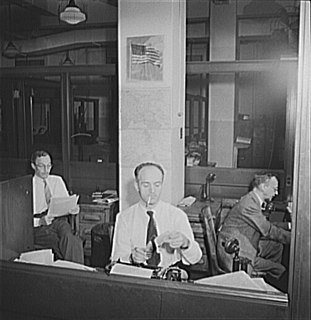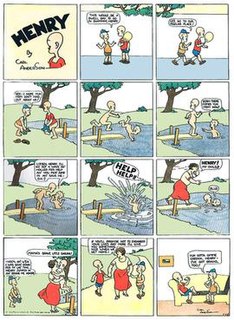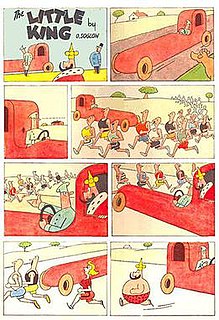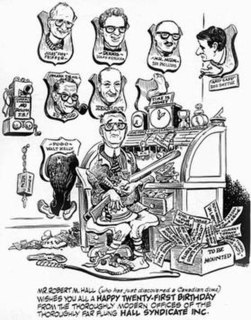
A comic strip is a sequence of drawings, often cartoon, arranged in interrelated panels to display brief humor or form a narrative, often serialized, with text in balloons and captions. Traditionally, throughout the 20th and into the 21st century, these have been published in newspapers and magazines, with daily horizontal strips printed in black-and-white in newspapers, while Sunday papers offered longer sequences in special color comics sections. With the advent of the internet, online comic strips began to appear as webcomics.

The Katzenjammer Kids is an American comic strip created by Rudolph Dirks in 1897 and later drawn by Harold Knerr for 35 years. It debuted December 12, 1897, in the American Humorist, the Sunday supplement of William Randolph Hearst's New York Journal. Dirks was the first cartoonist to regularly express comic characters' dialogue using speech balloons. The comic strip was turned into a stage play in 1903. It inspired several animated cartoons and was one of 20 strips included in the Comic Strip Classics series of U.S. commemorative postage stamps.
Yellow journalism and the yellow press are American terms for journalism and associated newspapers that present little or no legitimate, well-researched news while instead using eye-catching headlines for increased sales. Techniques may include exaggerations of news events, scandal-mongering, or sensationalism. By extension, the term yellow journalism is used today as a pejorative to decry any journalism that treats news in an unprofessional or unethical fashion.
Reed or Reeds may refer to:

Print syndication distributes news articles, columns, political cartoons, comic strips and other features to newspapers, magazines and websites. The syndicates offer reprint rights and grant permissions to other parties for republishing content of which they own and/or represent copyrights. Other terms for the service include a newspaper syndicate, a press syndicate, and a feature syndicate.

King Features Syndicate, Inc. is a print syndication company owned by Hearst Communications that distributes about 150 comic strips, newspaper columns, editorial cartoons, puzzles, and games to nearly 5,000 newspapers worldwide. King Features Syndicate is a unit of Hearst Holdings, Inc., which combines the Hearst Corporation's cable-network partnerships, television programming and distribution activities, and syndication companies. King Features' affiliate syndicates are North America Syndicate and Cowles Syndicate. Each week, Reed Brennan Media Associates, a unit of Hearst, edits and distributes more than 200 features for King Features.

Henry was a comic strip created in 1932 by Carl Thomas Anderson. The title character is a young bald boy who is mute. With the exception of a few early episodes, the comic strip character communicates only through pantomime, a situation which changed when Henry moved into comic books.

The New York Journal-American was a daily newspaper published in New York City from 1937 to 1966. The Journal-American was the product of a merger between two New York newspapers owned by William Randolph Hearst: The New York American, a morning paper, and the New York Evening Journal, an afternoon paper. Both were published by Hearst from 1895 to 1937. The American and Evening Journal merged in 1937.
A daily strip is a newspaper comic strip format, appearing on weekdays, Monday through Saturday, as contrasted with a Sunday strip, which typically only appears on Sundays.

The Sunday comics or Sunday strip is the comic strip section carried in most western newspapers, almost always in color. Many newspaper readers called this section the Sunday funnies, the funny papers or simply the funnies.

The Little King is a 1934-1975 American gag-a-day comic strip created by Otto Soglow, telling its stories in a style using images and very few words, as in pantomime.

Publishers-Hall Syndicate was a newspaper syndicate founded by Robert M. Hall in 1944. Hall served as the company's president and general manager. Over the course of its operations, the company was known as, sequentially, the Hall Syndicate (1944–1946), the New York Post Syndicate (1946–1949), the Post-Hall Syndicate (1949–1955), the Hall Syndicate (1955–1967), and Publishers-Hall Syndicate (1967–1975). The syndicate was acquired by Field Enterprises in 1967, and merged into Field Newspaper Syndicate in 1975. Some of the more notable strips syndicated by the company include Pogo, Dennis the Menace, Funky Winkerbean, Mark Trail, The Strange World of Mr. Mum, and Momma, as well as the cartoons of Jules Feiffer.

Radio Patrol was a police comic strip carried in newspapers from August 7, 1933 to December 16, 1950 in the dailies, with a Sunday strip that ran from November 25, 1934 to October 20, 1946. It was created by artist Charles Schmidt and writer Eddie Sullivan, who both worked for the Boston American. Sullivan was a newspaper reporter who specialized in crime reporting.
A comic strip syndicate functions as an agent for cartoonists and comic strip creators, placing the cartoons and strips in as many newspapers as possible on behalf of the artist. A syndicate can annually receive thousands of submissions, from which only two or three might be selected for representation. In some cases, the work will be owned by the syndicate as opposed to the creator. The Guinness World Record for the world's most syndicated strip belongs to Jim Davis' Garfield, which at that point (2002) appeared in 2,570 newspapers, with 263 million readers worldwide.

The McNaught Syndicate was an American newspaper syndicate founded in 1922. It was established by Virgil Venice McNitt and Charles V. McAdam. Its best known contents were the columns by Will Rogers and O. O. McIntyre, the Dear Abby letters section and comic strips, including Joe Palooka and Heathcliff. It folded in September 1989.

Edgar Stow Wheelan, who signed his work Ed Wheelan, was an American cartoonist best known for his comic strip Minute Movies, satirizing silent films, and his comic book Fat and Slat, published by DC Comics. He was one of the earliest writer-artists to introduce daily narrative continuity and cinematic techniques to comic strips.
The Bell Syndicate, launched in 1916 by editor-publisher John Neville Wheeler, was an American syndicate that distributed columns, fiction, feature articles and comic strips to newspapers for decades. It was located in New York City at 247 West 43rd Street and later at 229 West 43rd Street. It also reprinted comic strips in book form.

DailyINK was an online service created by King Features Syndicate to email many classic and current comic strips directly to subscribers for an annual fee of $19.99. King Features described it as "the all-inclusive subscription service for the true comics fan." On a web site and via email, the DailyINK service made available more than 90 vintage and current comic strips, panels, games, puzzles and editorial cartoons.
Associated Newspapers, Inc. was a print syndication service of columns and comic strips that was in operation from 1912 to c. 1966. The syndicate was originally a cooperative of four newspapers: The New York Globe, the Chicago Daily News, The Boston Globe, and the Philadelphia Bulletin. Associated Newspapers was led by Henry Herbert McClure (1874-1938), a cousin of S. S. McClure, founder of the McClure Syndicate, the first American newspaper syndicate. In 1930, Associated Newspapers was acquired by and became a subsidiary of the Bell Syndicate. The syndicate's most successful, long-running strip was Gladys Parker's Mopsy.











